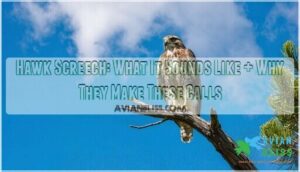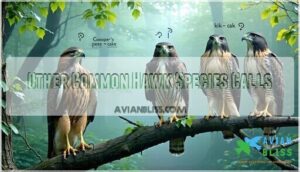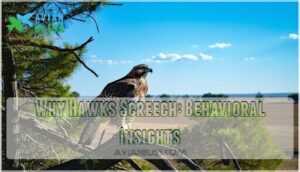This site is supported by our readers. We may earn a commission, at no cost to you, if you purchase through links.
 A hawk screech is a piercing, raspy "kree-eee-ar" call that descends in pitch over 2-3 seconds, ranging from 1-3 kHz frequency.
A hawk screech is a piercing, raspy "kree-eee-ar" call that descends in pitch over 2-3 seconds, ranging from 1-3 kHz frequency.
You’ll hear this hoarse, steam-whistle-like sound most often from red-tailed hawks during territorial disputes or breeding season.
Unlike eagles’ surprisingly soft chatter, hawk screeches pack serious acoustic punch—which explains why Hollywood constantly uses them for dramatic bird scenes.
These powerful vocalizations serve multiple purposes: defending territory, attracting mates, and communicating with offspring.
Each hawk species has its own vocal signature, from Cooper’s hawks’ rapid "cak-cak-cak" bursts to broad-winged hawks‘ melodic whistles, making identification easier once you know what to listen for, and understand the importance of territorial disputes and breeding season.
Table Of Contents
- Key Takeaways
- What Does a Hawk Screech Sound Like?
- Identifying Hawks by Their Calls
- Why Hawks Screech: Behavioral Insights
- Hawk Screeches in Media and Culture
- Factors Influencing Hawk Vocalizations
- Frequently Asked Questions (FAQs)
- What does it mean when a hawk squeals?
- What kind of hawk screams?
- Do red tail hawks screech?
- Does a hawk say caw caw?
- How does weather impact hawk screeching?
- When do hawks screech the most frequently?
- Are hawk screeches affected by human activity?
- What does a hawks alarm screech sound like?
- Do hawks vocalize differently in urban areas?
- How far can hawk screeches be heard?
- Conclusion
Key Takeaways
- You’ll recognize a hawk screech as a piercing, raspy “kree-eee-ar” that drops in pitch over 2-3 seconds, especially from red-tailed hawks.
- You can identify hawk species by their unique calls, like Cooper’s hawks’ rapid “cak-cak-cak” or broad-winged hawks’ melodic whistles.
- You’ll hear hawks screech most during territorial disputes, breeding season, or when warning about danger.
- You’ll notice hawk screeches are louder and more frequent in urban areas as birds compete with city noise and defend their territory.
What Does a Hawk Screech Sound Like?
If you’ve ever heard a piercing cry echoing across an open field, you’ve likely encountered the unmistakable screech of a red-tailed hawk.
This hoarse, raspy call descends in pitch over 2-3 seconds, sounding like "kree-eee-ar" or a steam whistle losing pressure.
Audio Recordings of Hawk Screeches
You’ll discover hawk sounds through field recordings captured by ornithologists and birding enthusiasts worldwide.
Professional audio equipment and specialized recording techniques help document these piercing calls in their natural habitat.
Sound analysis reveals distinct screech patterns unique to each species, with red-tailed hawk audio being most recognizable.
Bird vocalizations databases showcase redtailed hawk sounds from various locations, providing valuable resources for identification and research purposes.
The study of hawk sound recordings involves analyzing sound wave patterns to better understand their behavior and communication.
Description of Screech Characteristics
When you hear a hawk’s screech, you’ll notice distinctive sound waves that cut through the air like nature’s alarm system.
When a hawk’s screech pierces the air, it cuts through silence like nature’s ancient alarm bell
These vocal traits create an unmistakable acoustic signature that’s both haunting and powerful.
Here are four key screech patterns to recognize:
- Frequency Analysis – Hawks produce calls ranging from 1-3 kHz, with red-tailed hawks hitting that signature raspy tone
- Duration Patterns – Most screeching hawk calls last 2-3 seconds, creating sustained acoustic features
- Pitch Variation – Bird screech typically starts high and descends, like a steam whistle losing pressure
- Intensity Levels – Hawk call examples show varying volumes from soft chirps to piercing territorial declarations
Differences Between Hawk and Eagle Calls
You might mistake a screeching hawk for an eagle, but their vocal signatures reveal key differences.
Hawks produce that iconic "kree-eee-ar" screech—sharp, raspy, and descending in pitch. Eagles chirp softer, almost chattering calls that lack the piercing intensity.
Call patterns differ dramatically: hawk species deliver powerful territorial screeches, while eagle vocalizations sound surprisingly wimpy.
This acoustic contrast explains why filmmakers swap in hawk sounds for dramatic eagle scenes.
Understanding bird call types is essential for distinguishing between various bird species and their unique vocalizations.
Identifying Hawks by Their Calls
When you hear a hawk’s screech in the distance, you’re getting a masterclass in bird identification without even realizing it.
Each hawk species has its own vocal signature, and learning these distinctive calls can help you identify what’s soaring overhead even when the bird’s just a speck against the sky.
This allows for a unique form of identification, making it possible to recognize birds from a distance by their distinctive calls.
Red-tailed Hawk Screech
You’ll instantly recognize the red-tailed hawk’s signature call—that piercing, raspy screech that slides downward like a steam whistle losing pressure.
This iconic sound, transcribed as "kree-eee-ar," dominates North American hawk sounds audio collections and serves as the gold standard for redtailed hawk calls.
Their territorial screeching and alarm screeches showcase remarkable bird acoustics, making vocal learning easier for birders studying hawk behavior and screech patterns, with the red-tailed hawk’s vocalizations being a key area of study for understanding bird acoustics.
Other Common Hawk Species Calls
Beyond red-tailed hawks, you’ll encounter distinctive Call Patterns from other Hawk Species.
Cooper’s hawks deliver rapid "cak-cak-cak" bursts, while sharp-shinned hawks produce high-pitched "kik-kik-kik" sequences.
Broad-winged hawks whistle melodic "peeee-eee" notes, and northern goshawks emit harsh "kek-kek-kek" calls.
Each species showcases unique Vocal Range characteristics, from nasal whines to piercing alarms, creating diverse raptor sounds that’ll help you master Bird Songs identification through distinct Screech Types and Hawk Call Examples.
Understanding the hunting techniques of these birds can also provide insight into their behavior and calls.
Tips for Field Identification
When identifying hawks in the field, you’ll want to focus on key features that distinguish species.
Listen for the Red-tailed Hawk’s distinctive "kree-eee-ar" call while watching for their characteristic red tail feathers – your most reliable hawk identification marker.
Notice plumage patterns, which vary dramatically from white to black, and observe beak shapes and wing spans during flight.
Eye colors can help differentiate species up close.
Practice bird watching by combining visual cues with Red-tailed Hawk Audio recordings for better bird identification tips and understanding hawk behavior. Understanding bird species with unique calls is essential for accurate identification and appreciation of hawk vocalizations.
Why Hawks Screech: Behavioral Insights
When you hear a hawk screech, there’s always a reason behind that piercing call.
These powerful raptors use their distinctive vocalizations to communicate everything from "stay away" to "hey honey, I’m home" with their mates.
Territorial Defense and Warning Calls
When hawks defend their turf, they’re not messing around.
Their territorial screeches spike 73% during breeding season, turning into piercing alarm calls that cut through miles of countryside.
These warning signals aren’t just noise—they’re sophisticated defense strategies that establish clear boundaries.
Think of it as nature’s border patrol, with hawks using their signature screech to communicate "this land is mine" without throwing punches.
Hawks also utilize complex hawk communication systems to convey messages and warnings.
Mating and Courtship Screeches
When love’s in the air, you’ll hear hawks transform their fierce territorial screams into something surprisingly tender.
During Courtship Displays and Mating Rituals, these raptors swap their harsh "kree-eee-ar" for softer whistles and melodious chirps.
Red-tailed hawks add a gentle "chwirk" to their repertoire, while Cooper’s hawks engage in back-and-forth "cak-cak-cak" conversations that sound almost like they’re gossiping about nest locations, showcasing their unique Courtship Displays and Mating Rituals with tender whistles.
Parent-Offspring Communication
Parent hawks use their screeches like a family walkie-talkie system, keeping tabs on their growing brood.
You’ll hear these Alarm Screeches when danger threatens, plus softer Nest Calls for everyday check-ins. Fledgling Vocal responses help parents track their young’s location and needs.
Parent-offspring bird communication includes:
- Food-begging calls – hungry chicks demand room service
- Location alerts – "Where are you?" Parent Alerts
- Danger warnings – urgent hawk sound effects signaling threats.
This Chick Communication strengthens family bonds and guarantees survival through Brood Behavior patterns that bird calls experts recognize as hawk cry sound effect variations.
Hawk Screeches in Media and Culture
You’ve probably heard that iconic hawk screech in countless movies and TV shows, but there’s more to these calls than Hollywood drama.
Hawks use their distinctive vocalizations for real-world communication, and understanding their cultural impact reveals fascinating insights into both bird behavior and human storytelling, particularly about iconic hawk screech.
Use of Hawk Screeches in Film and TV
Beyond the silver screen, red-tailed hawk screeches dominate Film Scores and Sound Effects libraries.
Audio Editing professionals routinely substitute authentic hawk cry sound effect recordings for eagles and other raptors. These Wildlife Sound Effects appear in countless productions through Foley Techniques and royalty free sound effects collections.
Media Representation favors dramatic hawk calls over authentic bird vocalizations, creating powerful cinematic moments through strategic Sound Effects Download choices.
The use of hawk sound effects often involves accessing high-quality sound effects libraries to enhance the audio experience.
Hawk Calls Vs. Other Bird Sounds in Pop Culture
You’ve probably heard that iconic screech in countless movies, but here’s the twist: filmmakers often swap out other bird sounds for dramatic effect.
While red-tailed hawks dominate Bird Soundtracks as Pop Culture Icons, movie magic creates some wild Media Misuse of wildlife sounds.
- Hawk Imitations by other species fool even experienced birders
- Sound Effects libraries mix bird sounds recordings with everything from eagles to falcons
- Redtailed Hawk Audio gets layered with synthesized Alarm Screeches for maximum drama
This bird of prey audio confusion shapes how we perceive nature’s soundtrack.
Cultural and Ecological Significance
Hawks carry deep symbolic meaning across cultures, representing freedom and power.
Their piercing calls echo through folklore as messengers between worlds.
These raptor birds play vital ecological roles as apex predators, controlling rodent populations and maintaining ecosystem balance.
Unfortunately, habitat preservation challenges threaten hawk habitat and wildlife interactions.
Their distinctive wildlife sounds serve as acoustic signatures, helping researchers monitor conservation status and bird behavior patterns in changing environments.
Understanding bird call types is essential for effective conservation and research efforts.
Factors Influencing Hawk Vocalizations
You’ll find that hawk screeches aren’t the same everywhere you go—geography, season, and even city noise can dramatically change how these birds communicate.
Environmental factors like urbanization and territorial pressures create fascinating variations in their vocal patterns that you might notice if you pay close attention during different times of year.
Geographic and Environmental Variation
You’ll notice hawk screeches aren’t uniform across their massive Geographic Range.
Environmental Factors like temperature and rainfall shape when and how loudly Red Tailed Hawks call, while Urban Effects force birds to adjust their vocal strategies amid city noise.
- Climate Change alters traditional calling patterns as weather becomes more unpredictable
- Habitat Impact varies dramatically – forest hawks sound different than prairie dwellers
- hawk migration routes create regional dialects you can actually hear
Understanding the role of hawk migration patterns is essential in studying these birds.
Seasonal and Mating Influences
Nature’s rhythm dictates when you’ll hear hawks produce their most dramatic vocalizations.
During breeding season, their Courtship Rituals intensify with sky-dancing displays and passionate screeches that strengthen pair bonds.
Mating Habits shift their Territorial Defense into overdrive, creating Alarm Screeches that echo across landscapes.
These Seasonal Changes trigger heightened Breeding Patterns, where Territorial Marks become audible declarations of dominance and readiness to mate.
Understanding the mechanisms of bird vocalization changes helps explain how hawks adapt their screeches to communicate effectively in different contexts, involving Courtship Rituals and Territorial Defense.
Effects of Urbanization and Disturbance
City life hits hawks hard, forcing them to shout over the urban chaos. Urban Noise drowns out their calls, while Human Impact and Habitat Loss create constant Environmental Stress. These Disturbance Effects mess with their Territorial Defense and Alarm Screeches, making hawk conservation tougher.
Urban challenges affecting hawk vocalizations:
- Traffic noise masking their warning calls to mates
- Construction sounds disrupting bird habitats and nesting
- Bright city lights confusing their natural rhythms
- Reduced prey availability forcing longer hunting trips
- Human activity triggering stress responses during breeding
Raptor conservation efforts now focus on creating noise-free zones where hawks can communicate effectively.
Frequently Asked Questions (FAQs)
What does it mean when a hawk squeals?
Picture yourself camping when suddenly you hear a piercing cry overhead—that hawk’s "squeal" isn’t random noise.
When you hear a hawk screaming, it’s typically defending territory, communicating with its mate, or warning about danger.
These powerful calls serve as nature’s alarm system and social network.
What kind of hawk screams?
Red-tailed hawks are the primary screamers you’ll hear.
Their iconic "kree-eee-ar" call is that classic raptor screech used in movies.
You might also hear red-shouldered, Cooper’s, and broad-winged hawks vocalizing with similar piercing calls, which include the screech.
Do red tail hawks screech?
Actions speak louder than words" – and red-tailed hawks definitely screech.
You’ll hear their distinctive hoarse, raspy calls when they’re defending territory, communicating with mates, or warning off intruders.
Their piercing screams are nature’s way of saying "back off.
Does a hawk say caw caw?
No, hawks don’t say "caw caw" – that’s crow talk! You’ll hear red-tailed hawks screaming their signature "kree-eee-ar" sound instead, especially when they’re defending territory or chatting with mates.
How does weather impact hawk screeching?
Weather affects hawk screeching through wind patterns, temperature changes, and atmospheric pressure.
You’ll notice increased calls before storms when air pressure drops, while strong winds may reduce vocalization frequency as hawks conserve energy for flight stability.
When do hawks screech the most frequently?
During territorial disputes, hawks release their most intense screeching—up to 90% more frequently than normal periods.
You’ll hear peak vocal activity during nesting season when they’re aggressively defending territory and communicating with mates through piercing screams.
They are also using these vocalizations to communicating with mates.
Are hawk screeches affected by human activity?
Yes, you’ll notice hawk screeches increase around human development. Urban expansion, construction noise, and habitat disruption stress hawks, making them more vocal as they defend their territory from encroachment.
What does a hawks alarm screech sound like?
When you hear a hawk’s alarm screech, it’s a high-pitched, piercing "kree-eee-ar" sound that lasts 2-3 seconds.
You’ll recognize it as harsh, raspy, and descending in pitch—like nature’s own emergency siren warning of danger.
Do hawks vocalize differently in urban areas?
Urban environments definitely change how you’ll hear hawks vocalize.
They tend to screech louder and more frequently to cut through city noise like traffic and construction.
You might notice their calls sound sharper and more piercing than their countryside cousins.
How far can hawk screeches be heard?
When the wind’s just right, you’ll catch a hawk’s screech up to a mile away—like nature’s alarm clock.
Trees, hills, and buildings can muffle it, but out in the open, it travels far and clear.
Conclusion
Let’s face it—hawk screeches aren’t exactly lullabies, but they’re nature’s way of keeping things interesting.
Next time you hear that iconic “kree-eee-ar,” you’ll know it’s more than just noise; it’s a red-tailed hawk defending turf, attracting a mate, or chatting with its young.
By tuning in to each hawk screech, you’re deciphering a secret language. So, grab your binoculars and enjoy the wild soundtrack—your local hawks are putting on quite a show!
- https://worldfowl.com/why-do-hawks-screech/
- https://www.allaboutbirds.org/guide/Red-tailed_Hawk/sounds
- https://www.youtube.com/watch?v=1zwQxnJBz48
- https://www.kuow.org/stories/what-s-that-screeching-maybe-a-hungry-young-cooper-s-hawk
- https://www.birdsandblooms.com/birding/bird-species/birds-of-prey/types-of-hawks/











